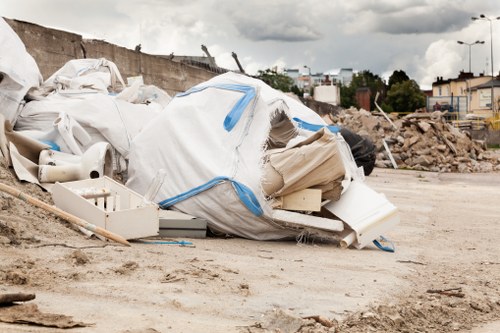Furniture Disposal in Hampstead: Your Complete Guide to Efficient and Eco-Friendly Solutions

When it comes to furniture disposal in Hampstead, homeowners and renters alike face the challenge of getting rid of unwanted pieces in a responsible and efficient manner. Whether you're upgrading your home, decluttering, or moving, understanding the best ways to dispose of your furniture can save you time, money, and environmental impact.
Hampstead, known for its charming streets and vibrant community, offers a variety of options for disposing of furniture. From recycling centers to donation services and professional removal companies, there's a solution tailored to your specific needs.
In this comprehensive guide, we'll explore the various methods available for furniture disposal in Hampstead, providing you with the information you need to make informed decisions.
Why Proper Furniture Disposal Matters

Proper furniture disposal is essential for several reasons, ranging from environmental sustainability to maintaining the aesthetic appeal of our neighborhoods. Improper disposal can lead to unnecessary waste, environmental pollution, and even legal consequences.
Environmental Impact: Old furniture often contains materials that can be harmful if not disposed of correctly. Recycling and donating extend the life cycle of these items, reducing the demand for new resources and minimizing landfill waste.
Health and Safety: Discarded furniture left in public spaces can become hazards. Broken or unstable pieces can cause accidents, while some materials may release toxic substances if not handled properly.
Environmental Impact of Furniture Disposal

Furniture items are typically made from wood, metal, plastics, and textiles. When these materials are not recycled or donated, they contribute to the growing problem of landfill overflow. By choosing eco-friendly disposal methods, you help conserve natural resources and reduce the carbon footprint associated with producing new furniture.
Recycling centers in Hampstead offer facilities to break down and repurpose old furniture. This not only minimizes waste but also supports local industries by providing materials that can be reused in new products.
Additionally, some furniture contains components that are recyclable or reusable. For example, wooden furniture can be repurposed into new items, metal parts can be melted down and reformed, and textiles can be used in fabric production.
Health and Safety Considerations

Improperly disposed furniture can pose significant health and safety risks. Sharp edges, unstable structures, and toxic materials are common hazards associated with discarded furniture.
By disposing of furniture through proper channels, you ensure that these items are handled safely. Professional removal services are equipped to dismantle and transport large or hazardous pieces, reducing the risk of injury to both individuals and the community.
Furthermore, recycling and donation centers often have protocols in place to sanitize and repair furniture before it's reused, ensuring that it is safe for future use.
Options for Furniture Disposal in Hampstead

Hampstead residents have access to a variety of furniture disposal options. Understanding the pros and cons of each can help you choose the best method for your situation.
From recycling centers and donation services to professional removal, each option offers unique benefits depending on your needs, budget, and the condition of your furniture.
Let's delve into each of these options to help you make an informed choice.
Recycling Centers
Recycling centers in Hampstead are dedicated to processing and repurposing old furniture. They accept a wide range of materials, ensuring that your unwanted items are transformed into usable resources.
- Wood Recycling: Wooden furniture can be broken down and used in new construction projects or as fuel in biomass energy facilities.
- Metal Recycling: Metal components from furniture are melted and reformed into new metal products, reducing the need for virgin materials.
- Textile Recycling: Fabrics from upholstered furniture can be recycled into new textiles or used in insulation materials.
Recycling not only helps the environment but can also free up space in your home without the guilt of contributing to landfill waste.
Donation Centers
If your furniture is still in good condition, donating it can be a great way to give back to the community. Hampstead boasts several reputable donation centers that accept gently used furniture for those in need.
- Charitable Organizations: Groups like the Salvation Army and local charities often accept furniture donations, providing essential items to families and individuals.
- Furniture Banks: These organizations collect and distribute donated furniture to those experiencing homelessness or hardship.
- Community Centers: Local community centers may also have donation programs or know of individuals in need within the area.
Donating furniture not only helps others but also reduces waste and promotes a sense of community support.
Professional Removal Services
For those who prefer a hassle-free approach, professional furniture removal services are the way to go. These companies handle everything from pickup to disposal, ensuring your old furniture is dealt with responsibly.
- Convenience: Professionals manage the entire process, saving you time and effort.
- Proper Disposal: Removal services ensure that furniture is disposed of according to local regulations and environmental standards.
- Cost-Effective: While there is a fee, professional services can be more economical in the long run, especially for large or numerous items.
Choosing a reputable removal service ensures peace of mind, knowing that your furniture is handled with care and responsibility.
Steps to Dispose of Your Furniture Responsibly

Disposing of furniture responsibly involves a series of steps to ensure minimal environmental impact and compliance with local regulations. Here's a step-by-step guide to help you through the process.
1. Assess the Condition: Determine whether your furniture is still usable. Items in good condition are ideal for donation, while broken or worn pieces may be better suited for recycling or disposal.
2. Choose the Right Option: Based on the condition assessment, decide whether to donate, recycle, or use professional removal services.
Assessment and Decision Making

Begin by evaluating the condition of your furniture. If it’s still functional and aesthetically pleasing, donation is a viable option. For items that are damaged but contain recyclable materials, recycling centers are the best choice. Finally, for furniture that is too large or in a condition unsuitable for donation or recycling, professional removal may be necessary.
Donation: Ideal for furniture that is clean, functional, and free from significant damage.
Recycling: Suitable for broken or old furniture that can be broken down into recyclable materials.
Preparing Furniture for Disposal

Proper preparation of your furniture can facilitate a smoother disposal process. Here are some tips:
- Clean the Items: Ensure that donated furniture is clean and presentable.
- Disassemble Large Pieces: Breaking down large furniture can make transport easier and reduce disposal costs.
- Remove Personal Items: Before donating or recycling, make sure to remove any personal belongings from the furniture.
Proper preparation not only makes the process easier but also increases the likelihood of your furniture being reused.
Contacting Disposal Services

Once you've decided on the disposal method, reach out to the relevant services. Whether it's scheduling a pickup with a professional removal service, dropping off items at a recycling center, or arranging a donation, timely action ensures efficient disposal.
When contacting these services, provide accurate information about the size and condition of your furniture to receive appropriate assistance.
Benefits of Choosing Eco-Friendly Disposal Methods
Opting for eco-friendly disposal methods offers numerous advantages, both for the environment and for the community.
- Reduces Waste: Recycling and donating reduce the amount of furniture that ends up in landfills.
- Conserves Resources: Reusing furniture extends the life of materials, conserving natural resources.
- Supports Local Communities: Donations help those in need, fostering a sense of community and support.
- Environmental Protection: Proper disposal methods minimize pollution and habitat destruction.
By choosing sustainable disposal options, you contribute to a healthier and more responsible Hampstead.
Conclusion
Disposing of furniture in Hampstead doesn't have to be a daunting task. With a range of options available, from recycling and donation to professional removal services, you can find a solution that fits your needs and values.
Remember to assess the condition of your furniture, choose the appropriate disposal method, and prepare your items properly. By doing so, you not only keep Hampstead clean and beautiful but also support environmental sustainability and community welfare.
Contact us today to learn more about your furniture disposal options or book your service now to ensure a hassle-free experience.